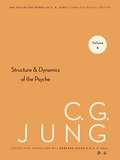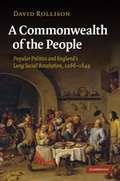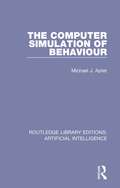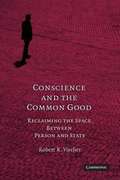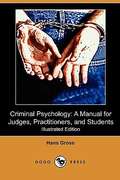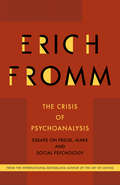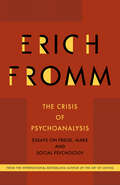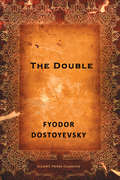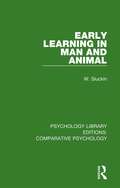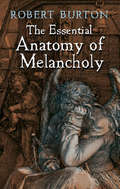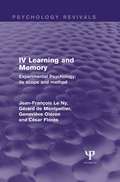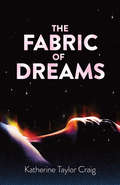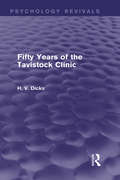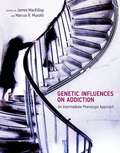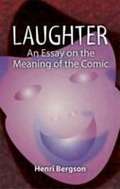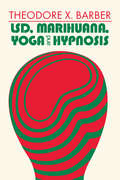- Table View
- List View
Collected Works of C. G. Jung, Volume 8: The Structure and Dynamics of the Psyche (The Collected Works of C. G. Jung #47)
by C. G. JungAn authoritative collection of Jung’s writings on analytical psychology, including SynchronicityThe Structure and Dynamics of the Psyche features a selection of Jung’s writings, ranging over four decades of his career, which illustrate the development of the conceptual foundations of analytical psychology. These pieces span the period from Jung’s break with Freud and the psychoanalytical school, when Jung began formulating his own theories, to the 1950s, when he published an account of his controversial theory of synchronicity.The contents are: On Psychic Energy • The Transcendent Function • A Review of the Complex Theory • The Significance of Constitution and Heredity in Psychology • Psychological Factors Determining Human Behavior • Instinct and the Unconscious • The Structure of the Psyche • On the Nature of the Psyche • General Aspects of Dream Psychology • On the Nature of Dreams • The Psychological Foundation of Belief in Spirits • Spirit and Life • Basic Postulates of Analytical Psychology • Analytical Psychology and Weltanschauung • The Real and the Surreal • The Stages of Life • The Soul and Death • Synchronicity: An Acausal Connecting Principle • On Synchronicity
A Commonwealth of the People
by David RollisonIn 1500 fewer than three million people spoke English; today English speakers number at least a billion worldwide. This book asks how and why a small island people became the nucleus of an empire 'on which the sun never set'. David Rollison argues that the 'English explosion' was the outcome of a long social revolution with roots deep in the medieval past. A succession of crises from the Norman Conquest to the English Revolution were causal links and chains of collective memory in a unique, vernacular, populist movement. The keyword of this long revolution, 'commonwealth', has been largely invisible in traditional constitutional history. This panoramic synthesis of political, intellectual, social, cultural, religious, economic, literary and linguistic movements offers a 'new constitutional history' in which state institutions and power elites were subordinate and answerable to a greater community that the early modern English called 'commonwealth' and we call 'society'.
The Computer Simulation of Behaviour (Routledge Library Editions: Artificial Intelligence #1)
by Michael J ApterThis book, originally published in 1970, concerns the new technique of computer simulation in psychology at the time. Computer programs described include models of learning, problem-solving, pattern recognition, the use of language, and personality. More general topics are discussed including the evaluation of such models, the relation of the field to cybernetics, and the problem posed by consciousness. Today it can be read and enjoyed in its historical context.
Conscience and the Common Good: Reclaiming the Space Between Person and State
by Robert K. VischerOur society's longstanding commitment to the liberty of conscience has become strained by our increasingly muddled understanding of what conscience is and why we value it. Too often we equate conscience with individual autonomy, and so we reflexively favor the individual in any contest against group authority, losing sight of the fact that a vibrant liberty of conscience requires a vibrant marketplace of morally distinct groups. Defending individual autonomy is not the same as defending the liberty of conscience because, although conscience is inescapably personal, it is also inescapably relational. Conscience is formed, articulated, and lived out through relationships, and its viability depends on the law's willingness to protect the associations and venues through which individual consciences can flourish: these are the myriad institutions that make up the space between the person and the state. Conscience and the Common Good reframes the debate about conscience by bringing its relational dimension into focus.
Control as Movement
by Cedric Boeckx Norbert Hornstein Jairo NunesThe Movement Theory of Control (MTC) makes one major claim: that control relations in sentences like 'John wants to leave' are grammatically mediated by movement. This goes against the traditional view that such sentences involve not movement, but binding, and analogizes control to raising, albeit with one important distinction: whereas the target of movement in control structures is a theta position, in raising it is a non-theta position; however the grammatical procedures underlying the two constructions are the same. This book presents the main arguments for MTC and shows it to have many theoretical advantages, the biggest being that it reduces the kinds of grammatical operations that the grammar allows, an important advantage in a minimalist setting. It also addresses the main arguments against MTC, using examples from control shift, adjunct control, and the control structure of 'promise', showing MTC to be conceptually, theoretically, and empirically superior to other approaches.
Criminal Psychology: A Manual for Judges, Practitioners, and Students
by Hans GrossCriminal Psychology is a book written by Hans Gross. It is widely considered to be one of the top 100 greatest books of all time. This great novel will surely attract a whole new generation of readers.Criminal Psychology is required reading for various courses and curriculums.
The Crisis of Psychoanalysis
by Erich FrommThis book brings together Erich Fromm's basic statements on the application of psychoanalytic theory to social dynamics. At the same time it offers an image of man consonant with the hopes of radical humanism. The Crisis of Psychoanalysis is a collection of nine brilliant essays. Although his work is deeply rooted in Freudian theory, Fromm further develops Freud's doctrines by including both social and ethical dimensions and applies his discoveries and insights to address the problems we face in society at large.
The Crisis of Psychoanalysis: Essays on Freud, Marx and Social Psychology
by Erich Fromm&“This book is must reading . . . although it will at times shock and perhaps even offend the sensibilities of traditional therapists.&” —American Journal of Psychiatry This book brings together Erich Fromm&’s basic statements on the application of psychoanalytic theory to social dynamics. At the same time, it offers an image of man consonant with the hopes of radical humanism.The Crisis of Psychoanalysis is a collection of nine brilliant essays. Although his work is deeply rooted in Freudian theory, Fromm further develops Freud&’s doctrines by including both social and ethical dimensions, and applies his discoveries and insights to address the problems we face in society at large. &“This collection is a fine representative sampling from a lucid, humane, always attractive writer.&” —Kirkus Reviews &“Highly recommended.&” —Library Journal
The Double
by Fyodor DostoyevskyAfter an uncomfortable and embarrassing evening at a party, the unsociable Golyadkin meets his double and soon discovers that this more charming and successful version of himself intends to take over his life and drive him to the edge of sanity.
Early Learning in Man and Animal (Psychology Library Editions: Comparative Psychology)
by W. SluckinOriginally published in 1970, this is a survey of findings on the learning of young animals and human infants. In an attempt to discover some of the characteristic features of early learning, it examines all types of learning from conditioning and the primitive process known as ‘imprinting’, usually associated with ducklings, to the beginnings of understanding and language. The so-called ‘critical’ periods for social learning and personality development are considered at some length, and a close look is taken at research methods used in studying early learning, and at the needs and problems of current research. As a textbook for students of psychology, biology and sociology this book would have been invaluable at the time of publication. It should still also be of interest to research workers in the fields of animal behaviour and developmental psychology, and to practising psychologists, psychiatrists and social workers, as it is an up-to-date summary of all the knowledge concerning early learning at the time.
The Essential Anatomy of Melancholy
by Robert BurtonEnglish churchman and scholar Robert Burton (1577-1640) was a passionate student of medicine, history, literature, and science — the whole of human knowledge. This witty and eloquent genius devoted most of this life to writing The Anatomy of Melancholy, one of the richest, most inexhaustible books in the English language.Ostensibly an elaborately systematized medical treatise dealing with various morbid mental states — their causes, symptoms, and cures — the Anatomy is much more: a compendium of memorable utterances on the human condition in general, compiled from classical, scholastic, and contemporary sources. For this edition, the editors carefully selected passages of the most psychological and general interest, eliminating the nonessential material but retaining the incomparable humor, eccentric charm, imagination, and thought-provoking appeal of the original.In short, readers will find here the essence of Burton's vast book — the passages that, according to noted scholar W. H. D. Rouse, reveal the author's "eternal freshness, his own ingenuous interest, [and] his boyish delight in a good story."
Experimental Psychology Its Scope and Method: Learning and Memory (Psychology Revivals)
by Jean François Le Ny Gérard de Montpellier Geneviève Oléron César FlorèsFirst published in English in 1970, the first chapter of the book is concerned with conditioned reactions. Jean François le Ny discusses ways in which conditioned reactions are acquired and the laws governing their function. The second contributor, Gérard de Montpellier, looks at different types of learning. The varying processes involved in both animal and human learning are considered, together with some general factors and mechanisms of learning. The third section of the book by Geneviève Oléron deals with the phenomenon of transfer. Among the topics included are the determination of transfer effects, transfer in perceptual-motor activities and explanations of transfer. In the final chapter, César Florès examines memory, forgetting and reminiscence. The discussion covers methodology, the influence of material, the role of practice, the part played by attitudes, motivation and emotive reactions in the memory process, as well as the importance of organisation of memory tasks on the part of the subject.
The Fabric of Dreams: Dream Lore and Dream Interpretation, Ancient and Modern
by Katherine Taylor CraigScience, history, symbolism, and collective wisdom combine for a fascinating blend of scholarship and spirituality in this exploration of ancient and modern dream lore and dream interpretation. Originally published in 1918, The Fabric of Dreams compiles dream-related beliefs and practices from a broad range of sources to offer a comprehensive and objective view of the subject. Readers are provided with a wealth of fact and fancy from which to arrive at their own conclusions. Author Katherine Taylor Craig, an expert on occult subjects, begins by drawing upon the literature and history of antiquity as well as medieval civilizations. In addition to age-old folklore, including methods of ancient divination, she cites scientists and psychiatrists such as Sigmund Freud, Carl Jung, Morton Prince, and Havelock Ellis, discussing and comparing their theories and explanations of dream phenomena. The teachings and observations of mystics such as William Blake and Madame Blavatsky receive their due, along with reflections from modern writers in the fields of literature, science, religion, art, and philosophy. Themes include dreams that have come true, dream analysis and interpretation, and the role of narcotics in inducing dream states. The book concludes with a guide to dream interpretation using the art of geomancy.
Fifty Years of the Tavistock Clinic (Psychology Revivals)
by H.V. DicksOriginally published in 1970 this title commemorates the men and ideas that started, inspired and established a pioneer institution in British psychiatry. Based on the impetus of Freudian and related innovations after the First World War, the Tavistock Clinic offered treatment, training and research facilities in the field of neurosis, child guidance and later on group relations. Dr Dicks, who had been associated for nearly forty years with the work and personalities that helped to develop the Tavistock venture, describes the struggles and capacity for survival of the clinic. He shows how, belonging neither to the older classical psychiatry nor to orthodox psychoanalysis, and suspect to both, the Clinic nevertheless became increasingly used by the rest of the profession as a psychotherapeutic resource. Dr Dicks describes the influence of the Tavistock on the medical, psychological and social work scene both before and after the Second World War, and assesses its achievements as a centre of psycho- and socio-dynamic thinking. The Tavistock is shown as a pioneer sui generis, launching psychosomatic research and initiating the exciting ventures in social psychiatry associated with the Army in the Second World War. As the Tavistock was the outcome of work with shell-shock victims in the first war, so its offspring, the Institute of Human Relations, was the natural continuation of the military effort in man-management, morale and group dynamic studies. The book includes an account of the inter-relationship between the Clinic, now part of the National Health Service, and the Institute, a private corporation. Still going strong as part of the Tavistock and Portman NHS Foundation Trust today this is an opportunity to revisit its early history.
Genetic Influences on Addiction
by James MackillopAlthough there is scientific consensus that genetic factors play a substantial rolein an individual's vulnerability to drug or alcohol addiction, specific genetic variables linked torisk or resilience remain elusive. Understanding how genetic factors contribute to addiction mayrequire focusing on intermediary mechanisms, or intermediate phenotypes, that connect geneticvariation and risk for addiction. This book offers a comprehensive review of thismechanistic-centered approach and the most promising intermediate phenotypes identified in empiricalresearch. The contributors first consider the most established findings in thefield, including variability in drug metabolism, brain electrophysiological profiles, and subjectivereactions to direct drug effects; they go on to review highly promising areas such as expectancies,attentional processing, and behavioral economic variables; and finally, they investigate moreexploratory approaches, including the differential susceptibility hypothesis and epigeneticmodifications. Taken together, the chapters offer a macro-level testing of the hypothesis that thesealternative, mechanistic phenotypes can advance the understanding of genetic influences onaddiction. The book will be of interest to researchers and practitioners in a range of disciplines,including behavioral genetics, psychology, pharmacology, neuroscience, andsociology. Contributors: John Acker, Steven R. H. Beach, Gene H. Brody, Angela D. Bryan, Megan J. Chenoweth, Danielle M. Dick, Eske D. Derks, Mary-Anne Enoch, Meg Gerrard, FrederickX. Gibbons, Thomas E. Gladwin, Mark S. Goldman, Marcus Heilig, Kent E. Hutchison, Hollis C. Karoly,Steven M. Kogan, Man Kit Lei, Susan Luczak, James MacKillop, Renee E. Magnan, Leah M. Mayo, MarcusR. Munafò, Daria Orlowska, Abraham A. Palmer, Danielle Pandika, Clarissa C. Parker, Robert A. Philibert, Lara A. Ray, Richard R. Reich, Ronald L. Simons, Courtney J. Stevens, Rachel E. Thayer,Rachel F. Tyndale, Tamara L. Wall, Reinout W. Wiers, Michael Windle, Harriet de Wit
Laughter: An Essay on the Meaning of the Comic
by Henri BergsonIn this great philosophical essay, Henri Bergson explores why people laugh and what laughter means. Written at the turn of the twentieth century, Laughter explores what it is in language that makes a joke funny and what it is in us that makes us laugh. One of the functions of humor, according to Bergson, is to help us retain our humanity during an age of mechanization. Like other philosophers, novelists, poets, and humorists of his era, Bergson was concerned with the duality of man and machine. His belief in life as a vital impulse, indefinable by reason alone, informs his perception of comedy as the relief we experience upon distancing ourselves from the mechanistic and materialistic. "A situation is always comic," Bergson notes, "if it participates simultaneously in two series of events which are absolutely independent of each other, and if it can be interpreted in two quite different meanings. " The philosopher's thought-provoking insights (e. g. , "It seems that laughter needs an echo. Our laughter is always the laughter of a group. ") keep this work ever-relevant as a thesis on the principles of humor.
LSD, Marihuana, Yoga, and Hypnosis
by Theodore X. BarberThe practice of yoga, hypnosis, and the use of psychedelic drugs to alter psychological and physiological states is not unknown to the study of psychology. They have been called "soft" studies and labeled unimportant. This is mostly because they are difficult to study and understand, often focusing on unobservable internal states such as altered states of consciousness, Samadhi, or hypnotic states. This book, in its approach to thinking about this topic and method for analysis, focuses only on phenomena that can be observed, such as behavioral changes.By centering on only those aspects of the psychological and physiological effects of yoga, hypnosis, and psychedelic drugs which can be measured and analyzed using this new method, Barber distinguishes this book from others in the field. He asks what overt behaviors and verbal reports are clearly observable when psychedelic drugs are taken, yoga is practiced, or hypnotic-induction procedures are administered. Instead of treating the phenomena traditionally associated with psychedelic drugs, yoga, or hypnosis as undifferentiated conglomerates, an attempt will be made to set apart and treat separately each of the many phenomena associated with each of these areas of inquiry.This book does not set out to simply demonstrate the importance of psychedelics, yoga, and hypnosis, or to present substantive material pertaining to these topics. It also treats each topic as continuous with other known psychological phenomena and as an important piece to the puzzle of social psychology. It differs from most previous treatises in that it does not assume that psychedelics, yoga, and hypnosis can bring out unused mental or physical capacities in man, heighten awareness or give rise to enhanced creativity, or produce altered states of consciousness, suspension of conventional reality-orientation, changes in body-image, or changes in perception.
Malignant Self Love
by Samuel VakninThe first ever book about narcissistic abuse, Malignant Self-love: Narcissism Revisited offers a detailed, first hand account of what it is like to have Narcissistic Personality Disorder. It contains new insights and an organized methodological framework. The first part of the book comprises more than 100 Frequently Asked Questions (FAQs) regarding relationships with abusive narcissists and the Narcissistic Personality Disorder.
